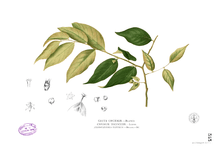Cleistanthus sumatranus
Cleistanthus sumatranus[3] is an accepted name of a tree species in the genus Cleistanthus (family Phyllanthaceae).[2][4] No subspecies are listed in the Catalogue of Life.[5]
| Cleistanthus sumatranus | |
|---|---|
 | |
| "Cleistanthus orgyalis",[1] which is a synonym of C. sumatranus | |
| Scientific classification | |
| Kingdom: | Plantae |
| Clade: | Tracheophytes |
| Clade: | Angiosperms |
| Clade: | Eudicots |
| Clade: | Rosids |
| Order: | Malpighiales |
| Family: | Phyllanthaceae |
| Genus: | Cleistanthus |
| Species: | C. sumatranus |
| Binomial name | |
| Cleistanthus sumatranus | |
| Synonyms[2] | |
|
Cleistanthus blancoi Vidal [Illegitimate] | |
It is found in dense deciduous or evergreen forests, from sea level to approximately 700 m (2,300 ft) in Brunei, Cambodia, southern China, Indonesia, Malaysia, Philippines, Singapore, Thailand, and Vietnam. In Chinese, it is called 闭花木 bi hua mu[6] and in Vietnamese Cách hoa (Sumatra).
Description
Cleistanthus sumatranus is an evergreen tree, growing up to 18 m (59 ft) tall.[6]
The leaves have 2–7 mm (0.079–0.276 in) petioles with elliptical leaf blades which are typically 30–100 mm (1.2–3.9 in) by 20–50 mm (0.79–1.97 in). Flowers are small, each with five sepals and five small petals (both male and female), with up to seven occurring in axillary fascicles, subtended by normal or smaller leaves, or on leafless spike-like axes. Flowering is typically from March–August; fruiting from April–October. The capsules are red and ovoid, approximately 10 by 10 mm (0.4 by 0.4 in), containing seeds which are usually single and up to 6 mm (0.24 in) in diameter.[6]
References
- Illustration circa 1880, from Francisco Manuel Blanco (O.S.A.) - Flora de Filipinas
- The Plant List (accessed 16 April 2017)
- de Candolle AP, 1866 In: Prodr. 15(2): 504
- WCSP: World Checklist of Selected Plant Families
- Roskov Y.; Kunze T.; Orrell T.; Abucay L.; Paglinawan L.; Culham A.; Bailly N.; Kirk P.; Bourgoin T.; Baillargeon G.; Decock W.; De Wever A. (2014). Didžiulis V. (ed.). "Species 2000 & ITIS Catalogue of Life: 2014 Annual Checklist". Species 2000: Reading, UK. Retrieved 26 May 2014.
- Flora of China (accessed 16 April 2017)
External links
